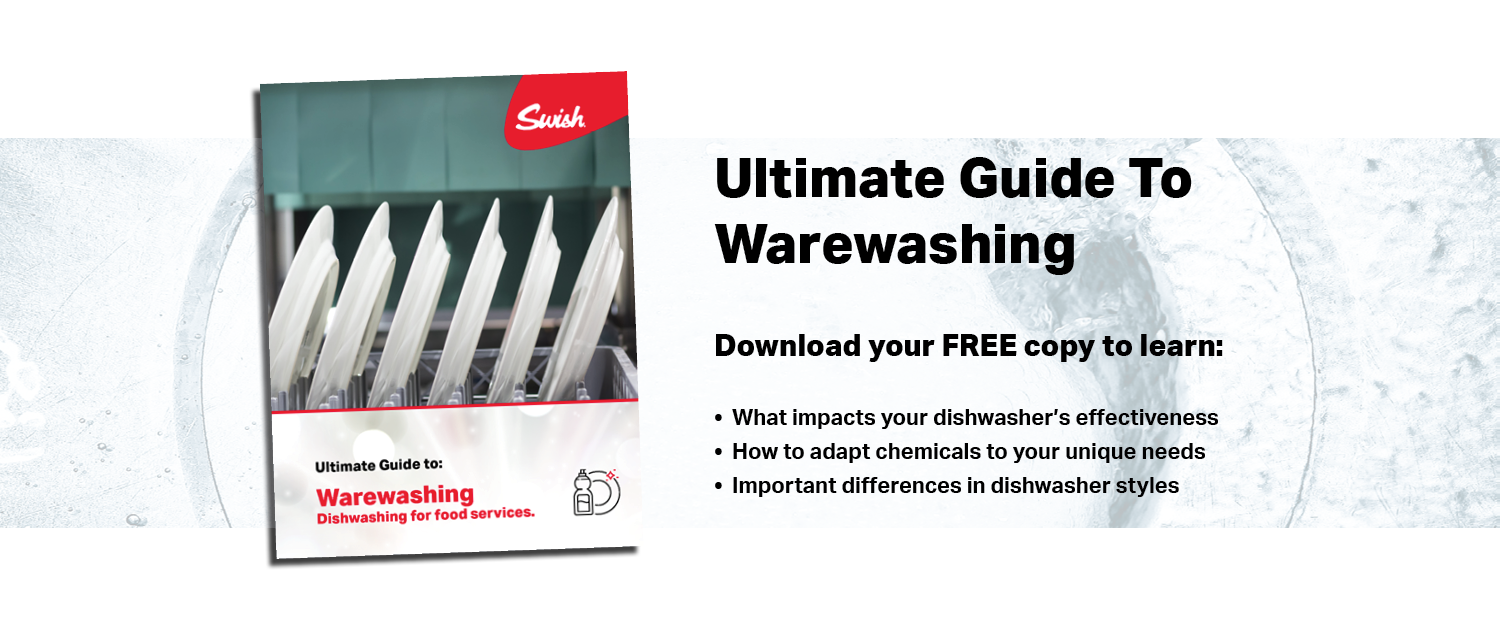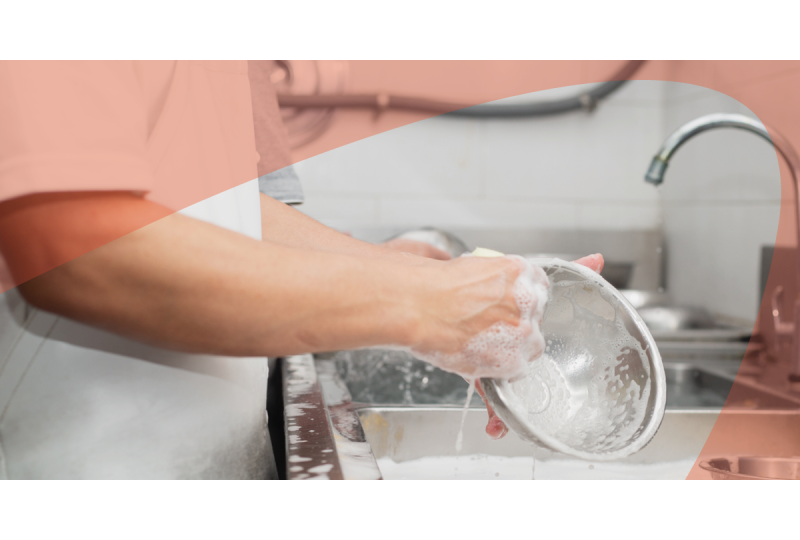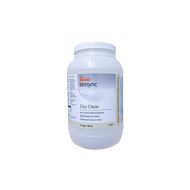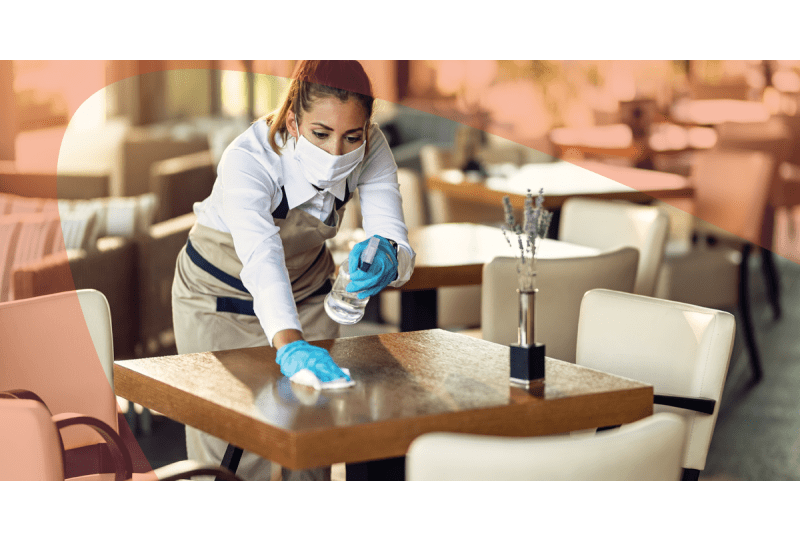If you invested in a top-of-the-line industrial dishwasher for your restaurant, cafeteria, or communal kitchen, have you noticed that dishes are starting to look no better coming out, than they did going in?
A lot can go wrong in pursuing clean, sanitized, and spotless dishes, cutlery, and glassware. The dishwashing machine itself is only part of the equation - selecting the right chemicals to use with your equipment determines how effective the cleaning will be to meet and exceed regulated standards.
The visual impact and perceived cleanliness when serving food are powerful; people may see water spots, rust stains, and etched glassware, and think they are unsanitary.
Preliminary Considerations For Choosing Chemicals
1) Equipment
If your staff are handwashing, you will need to use different dilutions of chemicals with the 3-bay sink system. We always recommend using gloves when manually washing dishes, however, these diluted formulas are much safer in case of skin contact.
High-temp dishwashers use sustained heat (140-160°F) and boost the heat to 180°F or higher on the final rinse to sanitize. They do not require additional sanitizing chemicals.
On the other hand, low-temp machines rely on chemical sanitation for the final rinse, typically ammonium (Quats) or chlorine.
2) Water Type
Hard water or TDS (total dissolved solids) is the mineral content of your water supply. Hard water can change the effectiveness of detergents, and rinse aids can cause more issues at high temperatures.
3) Food Served
The type of food soils you will remove also determines the solutions required to break them down correctly. Do you tend to serve more high protein, fried foods? Then you should opt for a high-temperature machine, and the relevant chemicals. Do you serve food or drinks that are delicate in flavour? The low-temperature sanitizer could affect the flavours.
4) The Materials Of Your Wares
Metal, glass, and plastics all react differently to chemicals and temperatures. Using a suitable combination of temperature, detergents, rinse aids, and sanitizers help to maintain your cutlery, glasses and dishes to maximize their useful life and save you money long-term.
Commercial Versus Residential Dishwashing
Commercial grade chemicals are very different from those used in residential dishwashers. Domestic dishwashers work at much lower temperatures, with longer cleaning cycles. While they typically require less energy to run, they will not achieve the sanitization standards necessary for high volume/public food services. The active cleaning ingredients in domestic detergents are also diluted and insufficient to use in the shorter cycles in industrial dishwashers. Alternatively, using commercial chemicals in your home dishwashing machine can be damaging, as the high concentrations can be corrosive.
As you can see, substituting or using incorrect chemicals could cause issues and lead to health code violations, so it’s essential to understand the types of commercial dishwashing chemicals available.
Next we will break down some common commercial warewash chemical types and their uses.

Common warewash chemicals
Detergents
Detergents are available in various options, adapted for water hardness and ware materials. Manufacturers also formulate them to work in either high or low-temperature dishwashers. There are three primary considerations based on your facility's environmental factors:
- Heavy Duty vs Metal Safe: Using heavy-duty detergents does not always mean you will get the best possible result; certain materials like soft metals require special detergents.
- Hard Water vs Soft Water: Depending on which minerals are present, hard water will require water-softeners. These can fluctuate over time, so it is best to test your water supply regularly.
- Chlorinated vs Non-Chlorinated: Chlorine is typically used for destaining in low-temperature machines but is not always safe. If you have high iron levels in the water or are washing precious metals, use a non-chlorinated detergent.
Sanitizers
Sanitizers are used in the final rinse (typically for low-temperature machines) and reduce the number of disease-causing organisms on wares, delivering broad-spectrum bacterial and fungicidal action.
Rinse Aids
Hard water tends to leave mineral deposits and spotting, particularly noticeable on glassware. Rinse aids are drying aids because they allow your wares to dry faster. They lower the surface tension of the water, so it doesn’t have a chance to deposit on the wares.
Descalers
These are either a single acid or a blend of acids that remove minerals. Descalers can be added to the wash tank and run for 15 minutes or however long it takes to remove the limescale.
Oxygen destainers
You can use destainers containing oxygen to safely and effectively destain coffee, tea and other food stains without harming the finishes. They are formulated to use at 120°F + on plates, trays, cups, mugs, glasses and even plastics.
Pre-soaks
The combination of alkalinity (create soap by dissolving fats) and surfactants (control the foam) in pre-soaks loosen food soils so that the detergent can clean more effectively.
Drain Cleaner
Sink drains are notorious sources of bacteria contamination, so regularly using a disinfecting drain cleaner avoids re-contamination. Degreasing drain cleaners help maintain clear drainage, and there are specific cleaners that help kill fruit fly larvae.
Assessing Your Commercial Dishwasher Requirements
Taking stock of your environment and adjusting the chemicals to suit will help you to achieve better results. Alternatively, you might have to re-assess the dishwasher machine you have installed. If you are still unsure which types of chemicals or equipment best suit your restaurant, cafeteria, or communal kitchen, our kitchen experts would be more than happy to help. Request a call today and see if you qualify for a free on-site assessment.








